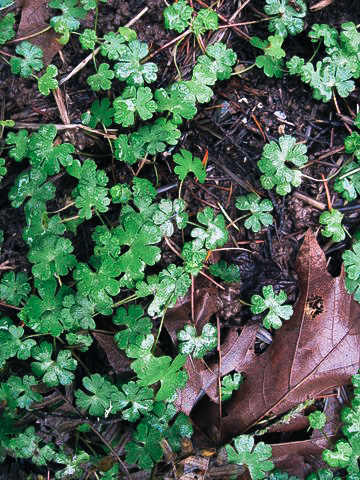
A small but perniciously invasive plant is headed to a yard near you. And trust me, this is not a plant you want in your own garden. One yard in my neighborhood (planted with natives, ironically) is currently blanketed with a near-continuous sheet of shining geranium’s glossy, bright green leaves.
Around 1989, Tom LoCascio, site manager at Mount Pisgah Arboretum, collected a plant specimen near Buford Park that was later identified by David Wagner (botanist, and writer and artist of EW’s “It’s About Time” column) as Geranium lucidum.
Within six years this plant was showing up elsewhere around Mount Pisgah and in other places throughout the state, and it was soon placed on the Oregon invasive species list.
According to Emily Steel of Parks Planning and Ecological Services, one of the first patches found locally by Eugene city staff was on Mount Baldy in 2005, and the plant was probably already established near a tractor shed at Hendricks Park by the early 2000s. Just a decade or so later it was found displacing other plants in many local parks and open spaces, and also in gardens.
Geranium lucidum, commonly known as shining geranium or shiny geranium, is a small, inoffensive-looking annual weed that appears after fall rains in a broad range of habitats. It can even grow where there is little or no soil — almost any substance that retains some moisture is good enough.
The roundish, glossy, bright-green leaves with scalloped edges are about an inch across. In winter the plants are close to the ground but they grow quickly, producing tiny, bright-pink flowers in April or May on branching stems that may reach 20 inches. Both the slender leaf stems and the brittle flowering stems are often red. Towards the end of the plant’s life cycle, the red stems can make dense colonies conspicuous even from a distance.
A single shining geranium plant can produce hundreds of seeds that its explosive capsules will shoot up to 20 feet. Thus a single plant can colonize a substantial area in one season.
Once shining geranium sneaks into a new area, it starts displacing whatever non-woody plants grew there before with such efficiency that some people suspect that it may be allelopathic, defined as the chemical inhibition of one plant by another through the release of substances that inhibit growth or germination.
The seeds can be passively carried much farther than 20 feet: on the clothing and footwear of people, the feet and fur of pets and wild animals, and also on vehicles and machinery.
If you like to hike or bike anywhere in Lane County or, for that matter, anywhere in western Oregon, California or Washington, the chances are you’ll eventually bring shining geranium home. And if you allow it to proliferate on your property, you can spread it to new territory yourself.
Staff at Hendricks Park and Mount Pisgah as well as several conservation agencies have tried many methods of control without coming close to eliminating shining geranium or even slowing its spread. Ed Alverson, natural areas coordinator for Lane County Parks, says, “It is pretty universally agreed that it is way beyond the possibility of eradication from the region.”
Efforts are now usually directed to removing small new colonies, treating infestations that threaten rare plants and treating areas adjacent to trails, parking lots and roadsides from which Geranium lucidum could easily be spread by visitors.
At Hendricks Park, a valiant effort is ongoing to prevent shining geranium getting established in the forest. Visitors to the park can help by cleaning their footwear, sticking to trails and keeping dogs on leash. Learn to identify this plant, and avoid walking through the areas where it grows. If you want to know what it looks like, take a look at the area around the rock restrooms on Fairmount and across the road, west of the picnic area.
One piece of good news for gardeners: It appears that certain organic methods are as effective as glyphosate (aka Roundup) at knocking back small patches of shining geranium. The best control is digging out any and all plants, roots and all. Repeated flaming works. In one study, vinegar and hot water (1:2) reduced infestations by 99 percent. The bad news is that any method of control must be repeated several times a year. And, of course, if there are other populations nearby, you can never let down your guard. ■
Rachel Foster lives and gardens in Eugene. There is an excellent U.S. Fish and Wildlife report on shining geranium you can find by searching online for “Summary of Biology and Control Methods in the Pacific Northwest for Geranium Lucidum.”